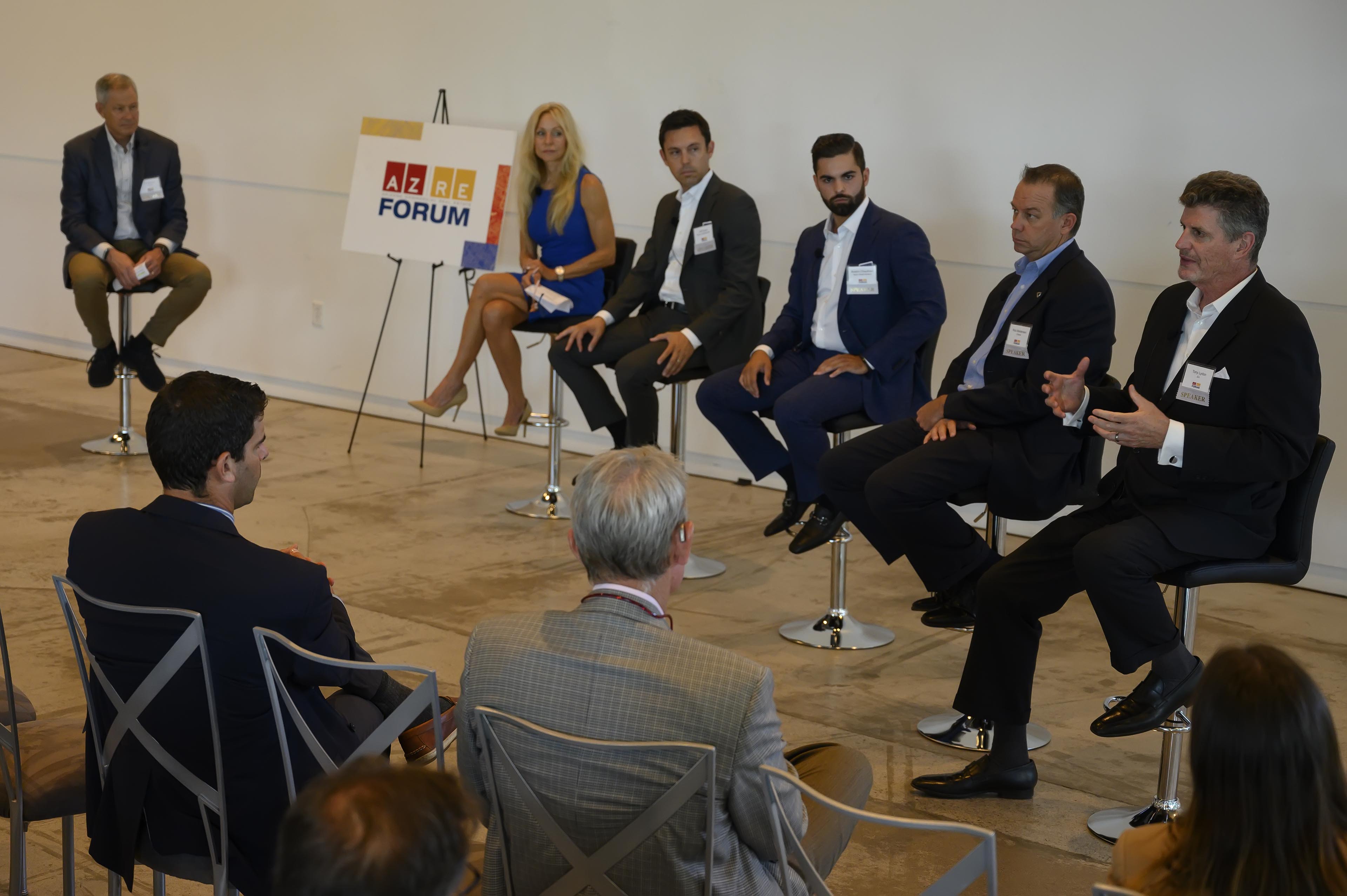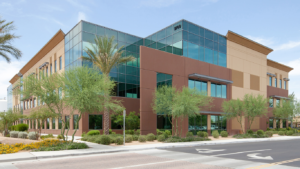Real estate is booming in Arizona. But how long can it be sustained? AZRE went straight to the experts to get their take on the commercial real estate outlook in Arizona.
Commercial real estate (CRE) professionals gathered at The Clayton House in Scottsdale on August 5 to hear from industry experts at the 7th Annual AZRE Forum. Panelists provided in-depth analysis of the industrial, office, retail and multifamily sectors; discussed the impacts of COVID-19; and forecast what could happen in the market in the future.
READ ALSO: How can Arizona keep up with increased construction labor demands?
“Our panelists are some of the most informed and accomplished people in their fields. Having them all together to discuss the commercial real estate outlook gives us insight that isn’t available anywhere else,” says Michael Gossie, editor-in-chief at AZ Big Media, which presented the event.
The panel sponsors for the AZRE Forum were NAI Horizon, MacQueen & Gottlieb, and Rise48 Equity. The beverage sponsor for the AZRE Forum was Enterprise Bank & Trust and the dessert sponsor was the City of Tempe. The audio sponsor was Phoenix Technology Audio Visual.
Here is the commercial real estate outlook and some key takeaways from the three panels.
BROKER PANEL
Opening the event was the Broker Panel, which gave an up-to-date look at the current state of CRE in Greater Phoenix. The status quo points to a positive trend for industrial products in the state.
Panelists
Bob Mulhern, Colliers – Moderator
Boston Chauthani, Taylor Street Advisors
Cliff David, Marcus & Millichap/IPA
Laurel Lewis, NAI Horizon
Tony Lydon, JLL
Rob Martensen, Colliers
“We’re fortunate to live in Arizona that has reasonable regulation and taxation. Because of that, we’re one of the few states that actually makes products,” comments Tony Lydon, managing director of JLL, referencing the influx of manufacturing companies that have located in Arizona.

West of the Colorado River, Southern California’s Inland Empire region is known an industrial powerhouse. Products shipped from Asia land in the ports of California. Greater Phoenix’s proximity to Inland Empire, however, makes it an attractive option for distributors.
“Inland Empire is always going to be king because 20 million people live in Southern California,” says Rob Martnesen, executive vice president with Colliers. “But now, instead of just having a giant building in Inland Empire and then distributing from there, companies are starting to say, ‘Maybe we just leave what product we can in the Inland Empire and put the rest in Phoenix.’”
Speaking to the robustness of the market, Cliff David, executive managing director for Marcus & Millichap’s Property Advisors division, notes, “Through the end of June, there were about $5.3 billion in sales. It’s reasonable to say we’ll do $11 billion to $12 billion by the end of the year.”
Even before the effects of the pandemic took hold, some were predicting the death of retail due to Amazon’s convenience and pervasiveness. But Boston Chauthani, vice president at Taylor Street Advisors, doesn’t hear retail’s death knell. “To a certain extent, there are some parts of the market that will die and change. Big box stores are going to downsize,” he says. “A lot of headlines are focused on mall deterioration, but small, multitenant strip malls are performing tremendously.”

COVID-19 IMPACT PANEL
Like every industry, the COVID-19 pandemic has had profound effects on CRE. The hospitality sector was especially hard hit due to stay-at-home orders and, after businesses began opening up again, wary consumers. Some planned projects were shelved because of the uncertainty caused by the crisis. It should also be mentioned that the pandemic has had profound effects on commercial property owners of apartment buildings, condominiums, and the like. With the eviction moratoriums that were put in place, many commercial real estate owners who served 30-day eviction notice forms in Arizona saw them become useless.
Panelists
Patrick MacQueen, MacQueen & Gottlieb – Moderator
Ben Darwin, CliftonLarsonAllen
Andrew Geier, Layton Construction
Derek Flottum, Irgens
Kimberly Rollins, Commercial Properties, Inc./CORFAC International

Still, people found a way to continue doing business. “Smaller tenants seemed to stay out of the office the shortest amount of time. But our large, publicly traded tenants still haven’t come back,” remarks Derek Flottum, vice president of development at Irgens.
Looking at the multifamily sector, Kimberly Rollins, senior vice president with CPI, notes that current conditions are far different than in 2008. “We thought we were headed into another 2008-style recession, but that didn’t happen,” she says. “In fact, the opposite occurred. A big difference this time is that people have money and they aren’t over-leveraged.”
Speaking to the construction industry, Andrew Geier, executive vice president at Layton Construction, says business boomed during the pandemic. Material costs, however, skyrocketed. “When COVID was ramping up, factories were ramping down because they thought demand was going away. As a result, prices on all materials have gone up, along with wait times. It used to take 10 to 12 weeks to get steel joists. Now it takes 10 to 12 months.”

COMMERCIAL REAL ESTATE OUTLOOK
Overall, the panelists believe that Greater Phoenix has set itself up for a bright future thanks to a favorable business environment, well-built infrastructure and being a destination for transplants from across the nation.
Panelists
Suzanne Kinney, NAIOP – Moderator
Jamie Godwin, Stevens-Leinweber
Ben Gottlieb, MacQueen & Gottlieb
John Kinser, Enterprise Bank
Kristen Stephenson, GPEC
But there are challenges on the horizon, due to an insufficient construction labor pool. Without enough workers on a jobsite, timelines begin to stretch, which increases costs.
Nevertheless, organizations such as the Greater Phoenix Economic Council (GPEC) are working hard to keep the investments flowing into the state. “GPEC had great success the last fiscal year, bringing 10,000 jobs to the Valley. There has been a shift in what is coming. In the past, it has been half industrial and half office, but now it’s closer to two thirds being manufacturing,” remarks Kristen Stephenson, senior vice president of research and analytics at GPEC.
Looking forward, Jamie Godwin, owner and president of Stevens-Leinweber Construction, adds, “We’ve been extremely busy with speculative office suites and smaller-sized spaces over the last 12 months, and the bigger deals are starting to come back on the market. I think we’ll return to same activity level that we were at before the pandemic by the end of next year.”
Closing out the event, Stephenson predicts, “Greater Phoenix is going to become the semiconductor and electronic vehicle hub of the country, if not the world.”





